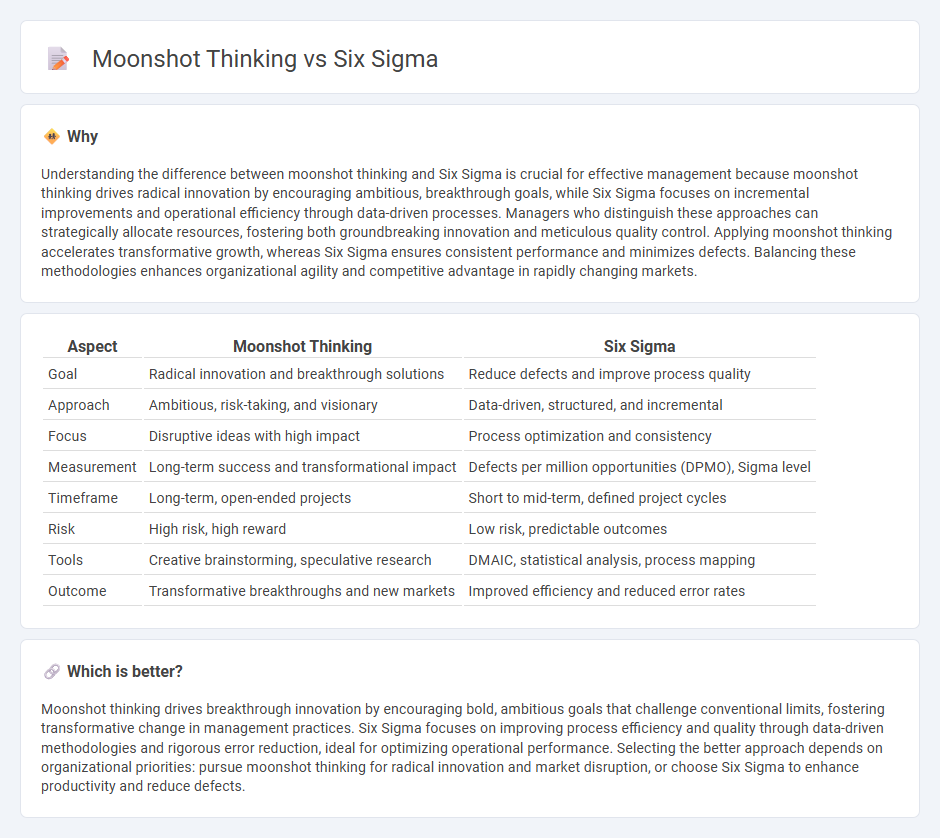
Moonshot thinking focuses on bold, innovative goals that aim for breakthrough progress by embracing radical ideas and disruptive technologies. Six Sigma emphasizes data-driven management techniques to improve processes and reduce defects through structured methodologies like DMAIC. Explore how combining these approaches can transform organizational performance and drive sustainable growth.
Why it is important
Understanding the difference between moonshot thinking and Six Sigma is crucial for effective management because moonshot thinking drives radical innovation by encouraging ambitious, breakthrough goals, while Six Sigma focuses on incremental improvements and operational efficiency through data-driven processes. Managers who distinguish these approaches can strategically allocate resources, fostering both groundbreaking innovation and meticulous quality control. Applying moonshot thinking accelerates transformative growth, whereas Six Sigma ensures consistent performance and minimizes defects. Balancing these methodologies enhances organizational agility and competitive advantage in rapidly changing markets.
Comparison Table
| Aspect | Moonshot Thinking | Six Sigma |
|---|---|---|
| Goal | Radical innovation and breakthrough solutions | Reduce defects and improve process quality |
| Approach | Ambitious, risk-taking, and visionary | Data-driven, structured, and incremental |
| Focus | Disruptive ideas with high impact | Process optimization and consistency |
| Measurement | Long-term success and transformational impact | Defects per million opportunities (DPMO), Sigma level |
| Timeframe | Long-term, open-ended projects | Short to mid-term, defined project cycles |
| Risk | High risk, high reward | Low risk, predictable outcomes |
| Tools | Creative brainstorming, speculative research | DMAIC, statistical analysis, process mapping |
| Outcome | Transformative breakthroughs and new markets | Improved efficiency and reduced error rates |
Which is better?
Moonshot thinking drives breakthrough innovation by encouraging bold, ambitious goals that challenge conventional limits, fostering transformative change in management practices. Six Sigma focuses on improving process efficiency and quality through data-driven methodologies and rigorous error reduction, ideal for optimizing operational performance. Selecting the better approach depends on organizational priorities: pursue moonshot thinking for radical innovation and market disruption, or choose Six Sigma to enhance productivity and reduce defects.
Connection
Moonshot thinking and Six Sigma are connected through their shared focus on innovation and process improvement aimed at achieving exceptional business outcomes. Moonshot thinking encourages bold, breakthrough goals that push boundaries, while Six Sigma provides a data-driven methodology to systematically reduce defects and enhance quality. Integrating moonshot thinking with Six Sigma enables organizations to pursue ambitious innovations with disciplined execution, optimizing operational efficiency and transformative growth.
Key Terms
Process Improvement
Six Sigma emphasizes rigorous data-driven methodologies to reduce process variation and improve quality, achieving incremental gains through defined statistical tools. Moonshot thinking encourages radical innovation by pursuing ambitious, groundbreaking goals that transform processes rather than optimizing existing ones. Explore the distinctions between these approaches to understand the best strategy for your organization's process improvement initiatives.
Innovation
Six Sigma emphasizes process optimization and defect reduction through data-driven methods, achieving incremental improvements in quality and efficiency. Moonshot thinking drives radical innovation by aiming for breakthrough advancements that challenge conventional limits and create transformative solutions. Explore how these contrasting approaches can reshape your innovation strategy for maximum impact.
Risk Appetite
Six Sigma emphasizes minimizing variability and defects through structured, data-driven processes, appealing to organizations with a low risk appetite aiming for consistent quality improvements. Moonshot thinking encourages bold innovation and breakthrough ideas by embracing high uncertainty and risk, suitable for ventures targeting transformative change. Explore how aligning your risk appetite with these methodologies can drive optimal strategic outcomes.
Source and External Links
What is Lean Six Sigma? - Six Sigma is a method for disciplined quality improvement aimed at enhancing business process capabilities by reducing defects and process variation.
Six Sigma - Six Sigma is a set of techniques and tools for process improvement, emphasizing data-driven decisions and leadership commitment to achieve measurable financial returns.
What Is Six Sigma? - Six Sigma is a data-driven approach that uses structured methodologies to eliminate defects in processes, requiring senior leadership commitment and organizational involvement.
 dowidth.com
dowidth.com